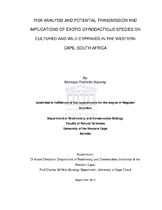| dc.description.abstract | The expansion of the South African aquaculture industry coupled with the lack of effective parasite management strategies may potentially have negative effects on both the freshwater biodiversity and economics of the aquaculture sector. Koi and goldfish are notorious for the propagation of parasites worldwide, some of which have already infected indigenous fish in
South Africa. Koi and goldfish have been released into rivers in South Africa since the 1800’s for food and sport fish and have since spread extensively. These fish are present in most of the river systems in South Africa and pose an additional threat the indigenous cyprinids in the Western Cape. Monogenean parasites of the genus Gyrodactylus are of particular concern, as their unique biology renders them a possible threat. Gyrodactylus
kherulensis and G. kobayashii were identified from koi and goldfish respectively imported from Asia, Europe and locally bred fish. Morphometrics and the use of statistical classifiers, which includes univariate (ANOVA and Kruskal-Wallis), bivariate (Pearson’s correlation) and multivariate (Principal Component Analysis) placed the two species within their respective groups. There was some intraspecific variation among the different populations
collected from the various locations, especially in the hamulus and ventral bar features, but the marginal hooklets, however, remained static for both helminth species. This illustrates again the importance of the minor variations in the marginal hook features in gyrodactylid taxonomy. Infection trials conducted by co-habitation of infected koi and goldfish with two indigenous redfin minnow species, Pseudobarbus burchelli and P. phlegethon showed that
both G. kherulensis and G. kobayashii could successfully transfer and establish themselves on P. phlegethon, where the infection increased rapidly initially, but remained relatively constant thereafter. P. burchelli appeared to be inherently resistant as the parasite population growth rate initially remained steady, until the infection died off. The wild-caught indigenous fish were however not infected with any exotic Gyrodactylus species, but a new species, G. burchelli n. sp. described from the body surfaces of P. burchelli. | en_US |

